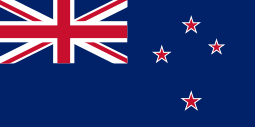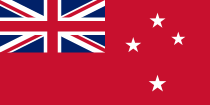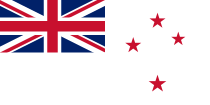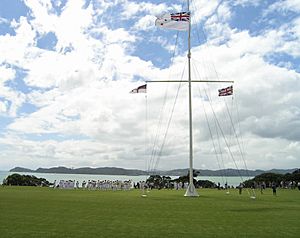Flag of New Zealand facts for kids
 |
|
| Use | National flag and state ensign |
|---|---|
| Proportion | 1:2 |
| Adopted | 24 March 1902 (In use since 1869) |
| Design | A Blue Ensign with a Union Jack in the first quarter and four five-pointed red stars with white borders on the fly representing the Southern Cross. |
| Designed by | Albert Hastings Markham |

Variant flag of New Zealand
|
|
| Name | New Zealand Red Ensign |
| Use | Civil ensign |
| Proportion | 1:2 |
| Adopted | Introduced in 1903. |
| Design | A Red Ensign with a Union Jack in the first quarter and four five-pointed white stars on the fly representing the Southern Cross. |

Variant flag of New Zealand
|
|
| Name | New Zealand White Ensign |
| Use | Naval ensign |
| Proportion | 1:2 |
| Adopted | Introduced in 1968. |
| Design | A defaced British White Ensign without the cross. The cross is replaced with the Southern Cross. |

Variant flag of New Zealand
|
|
| Name | Royal New Zealand Air Force Ensign |
| Use | Air force ensign |
| Proportion | 1:2 |
| Adopted | Introduced in 1939. |
| Design | A modified form of the RAF Ensign with the letters "NZ" superimposed in white over the central red disc. |
The flag of New Zealand (called Te haki o Aotearoa in Māori) is the country's national flag. It's mostly blue, with the Union Jack (the flag of the United Kingdom) in the top left corner. On the right side, you'll see four red stars with white outlines. These stars represent the Southern Cross constellation, which is a group of stars visible in the Southern Hemisphere.
New Zealand's first national flag was the flag of the United Tribes of New Zealand. It was chosen in 1834 by Māori chiefs. This was six years before New Zealand became a separate colony in 1840. The current flag was designed in 1869 for ships. It quickly became New Zealand's national flag and was officially recognized in 1902.
For many years, people have talked about changing the flag. In 2016, New Zealand held two votes to decide if the flag should change. In the end, the country voted to keep the flag it already had. About 57% of voters chose to keep the old flag.
Contents
History of the New Zealand Flag
The First Flag: United Tribes

New Zealand needed its own flag for a simple reason. A trading ship called Sir George Murray was stopped in Australia. It was sailing without a flag, which was against British rules. At that time, New Zealand was not a colony and had no flag. This made the Māori people upset. To avoid more problems, a flag had to be chosen.
The first flag of New Zealand was chosen on March 9, 1834. This happened at a meeting of Māori chiefs called the United Tribes of New Zealand. The meeting was held at Waitangi. Three flag designs were suggested by a missionary named Henry Williams. The chiefs chose a design similar to the St George's Cross. This flag became known as the flag of the United Tribes of New Zealand. It showed that the Māori chiefs wanted to be independent.
This historic flag is still flown today at Waitangi, especially on Waitangi Day.
- Flag of the United Tribes
The British Union Flag
After the Treaty of Waitangi was signed in 1840, the British Union Flag became the official flag. However, some ships and places in New Zealand still used the old United Tribes flag. For example, the settlement in Wellington kept using it until they were told to change by Governor William Hobson in May 1840.
The Current Flag Design

The first New Zealand flag that looked like the current one appeared in 1867. This was because a new law said that all ships owned by colonial governments needed to fly a special blue flag. This flag had to have a colonial symbol. New Zealand didn't have a symbol yet, so they just added the letters "NZ" to the blue flag.
In 1869, a British Navy officer named Albert Hastings Markham suggested a new flag design. He added the Southern Cross stars to the blue flag. This design was approved by the Governor of New Zealand, Sir George Bowen. At first, only government ships used it. But soon, it became the unofficial national flag. To clear up any confusion, the government passed a law in 1902. This law officially made the flag with the Southern Cross New Zealand's national flag.
- Flags based on defaced Blue ensign
-
The Blue Ensign.
The Flag in Battle
One of the first times the New Zealand flag was seen in battle was during World War I. This happened at Quinn's Post in Gallipoli in 1915. However, it wasn't officially flown there. The first time the flag was officially used in a naval battle was in 1939. This was during the Battle of the River Plate, flown from the HMS Achilles.
Debating the Flag's Future
For many years, people in New Zealand have discussed whether to change the national flag. This debate started even before 1973. In 1979, a government minister suggested a new design with a silver fern. However, not many people supported this idea.
Later, in 1998, Prime Minister Jenny Shipley also supported changing the flag. She liked a design with a white silver fern on a black background. This was similar to Canada's flag, which has a maple leaf.
The 2015–2016 Flag Referendums
On March 11, 2014, Prime Minister John Key announced that New Zealand would hold a vote on a new flag. There would be two votes, called referendums. The first vote happened in November 2015. People chose their favorite design from five options. The second vote was in March 2016. In this vote, people chose between the winning design from the first vote and the current flag.
If the flag had changed, the old flag would still be allowed to be used. It would be seen as a flag with historical importance. Official documents like driver's licenses would still be valid. They would be replaced with the new flag design over time.
On December 11, 2015, the results of the first vote were announced. The winning design was a blue and black flag with a silver fern and red stars. However, this design did not win the second vote. On March 24, 2016, the results showed that New Zealanders voted to keep their current flag. About 56.7% of people voted to keep the flag. Only six of New Zealand's 71 voting areas chose to change the flag.
Flags with Similar Designs
The New Zealand flag was the first national flag to show only the four main stars of the Southern Cross constellation. These stars form the actual cross shape. Each star on New Zealand's flag is red with a white outline.
The Australian flag, adopted in 1901, also has the Union Flag and the Southern Cross. However, the Australian flag has six white stars. Five of these stars have seven points, and one has five points. Australia's flag also has a large Commonwealth Star below the Union Flag. This star is a symbol of Australia.
Many other flags also include the Southern Cross constellation. Some of these flags date back to the early 1800s.
Other Flags of New Zealand
Here are some other flags used in New Zealand.
- Other flags of New Zealand
-
Naval Ensign
-
Tino Rangatiratanga, Māori Sovereignty flag
Images for kids
-
The flag of New Zealand flying outside the Beehive in Wellington
-
The flag flying at half-mast from the Matariki Building at University of Canterbury on the day of the death of Sir Edmund Hillary
See also
 In Spanish: Bandera de Nueva Zelanda para niños
In Spanish: Bandera de Nueva Zelanda para niños





















